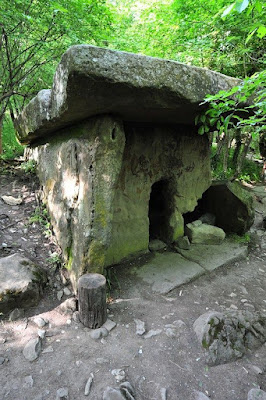"Pictogram representing an earthquake that took place on the year 2 Reeds or 1507. The gloss describes that the pictogram recounts the drowning of 1800 warriors in an unidentified river, presumably in southern Mexico, the termination of the temple of the New Fire, where the ceremony of the new cycle of life was celebrated, and a solar eclipse as a circle with rays emanating from it in the upper right-hand side, below the date sign." Suarez and Garcia Acosta, 2021, Fig. 7, page 5.
On Saturday, October 19, 2013, I posted a column on RockArtBlog titled “An Earthquake Symbol Pictograph” about a pictograph in the Stein River Valley of British Columbia, Canada, that was interpreted by a First Nations informant (Annie York) as a symbol for an earthquake. Now a 2021 paper by Gerardo Suarez and Virginia Garcia-Acosta (see references) has identified an Mesoamerican earthquake pictogram and illustrated a number of instances of its use in codexes (actually codices).
“The first written evidence of earthquakes in the Americas is represented as pictograms in codices and annals drafted in the first few years after the Spanish Conquest. The main source of earthquakes in pre-Hispanic times comes from the codex Telleriano-Remensis. There are 12 earthquakes reported in the Telleriano-Remensis, from 1460 to 1542.” (Suarez and Garcia-Acosta 2021:1)
“The Codex Telleriano-Remensis, produced in sixteenth century Mexico on European paper, is one of the finest surviving examples of Aztec manuscript painting. The Codex Telleriano-Remensis is divided into three sections. – The third section is a history, itself divided into two sections which differ stylistically. Pages 25 to 28 are an account of migrations during the 12th and 13th centuries, while the remaining pages of the codex record historical events, such as ascensions and deaths of rulers, battles, earthquakes, and eclipses from the 14th to the 16th century, including events of early Colonial Mexico.” (Wikipedia)
Suarez and
Garcia-Acosta (2021) describe the earthquake glyphs as follows. “Earthquakes, or tlalollin in the original
Nahuatal language, are represented by two associated glyphs: movement or ollin
and Earth or tlalli. Thus the two signs depicted together represent an
earthquake. The glyph ollin represents movement. It is portrayed as four
helices and a central circle or eye. The Earth is represented by one or several
layers filled with dots and colored in different hues. The time of occurrence
of an earthquake is depicted by the central part of the ollin or eye. For
earthquakes occurring during the day, the eye is open; it is shown as closed
for other earthquakes occurring at night.” (Suarez and Garcia-Acosta
2021:2-3) Now any definition I can find of the word helix or helices refers to
them as spirals in form and the projections from the central circle of the ollin are obviously not helices, I would
describe them as projecting forms on either side, each side divided by notches
into three portions for a total of six sections.
We take it as an article of faith that the cultures of the American southwest and of Mexico and Mesoamerica knew something of each other, traded with each other, and had some influences of each other’s cultures.
I have found an image of a rock art symbol at Glorieta Mesa, New Mexico, which actually looks remarkably like this a portion of this earthquake symbol. In 2008 Larry Loendorf wrote of the Glorieta Mesa petroglyphs -“Many circles are simply concentric, but they can also be embellished by rays projecting from their outer ring. In some instances circles are divided into segments by lines radiating from the center, which make s them look like another natural form, the sand dollar. Some concentric circles have smaller, irregularly shaped ‘petals’ at intervals around the outermost ring.” (Loendorf 2008:61)
This symbol from Glorieta Mesa also has central concentric circles with six projections coming from the outer circle. Is this actually intended to be a copy of the Aztec ollin or Earth glyph? I really cannot say, but it is intriguing. It might not deserve the cigar but it is close.
NOTE: Some images in this posting were retrieved from the internet with a search for public domain photographs. If any of these images are not intended to be public domain, I apologize, and will happily provide the picture credits if the owner will contact me with them. For further information on these reports you should read the original reports at the sites listed below.
REFERENCES:
Loendorf, L., 2008, Thunder and Herds: Rock Art of the High Plains, Left Coast Press, Walnut Creek, California.
Suarez, Gerardo, and Virginia Garcia-Acosta, 2021, The First Written Accounts of Pre-Hispanic Earthquakes in the Americas, Seismological Research Letters, www.srl-online.org, Volume XX, No. XX
Wikipedia, Codex Telleriano-Remensis, https://en.wikipedia.org/wiki/Codex_Telleriano-Remensis
York, Annie, Richard
Daley and Chris Arnett, 1993 They Write Their Dream on the
Rock Forever: Rock Writings of the Stein River Valley of British Columbia,
Talonbooks, Vancouver, B.C.




































